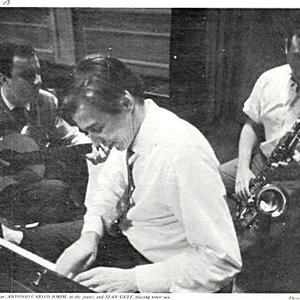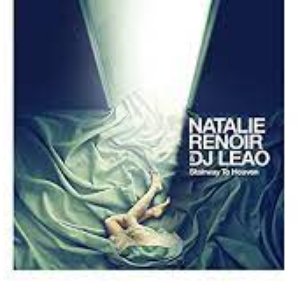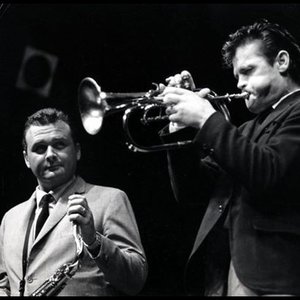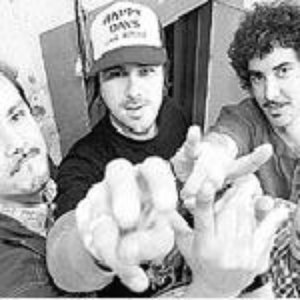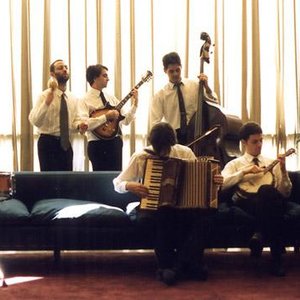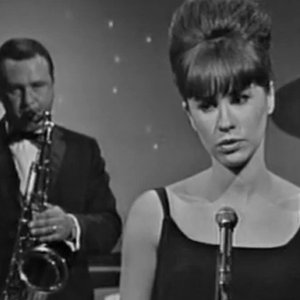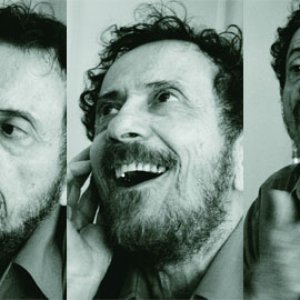Biography
Getz/Gilberto is an album by American saxophonist Stan Getz and Brazilian guitarist [artistJoão Gilberto, featuring pianist and composer Antônio Carlos Jobim (Tom Jobim), who also composed many of the tracks. It was released in March 1964 on Verve Records. The album features the vocals of Astrud Gilberto on two tracks, "Garota de Ipanema" ("The Girl from Ipanema") and "Corcovado". The artwork was done by artist Olga Albizu. Getz/Gilberto is a jazz and bossa nova album, and includes tracks such as "Desafinado", "Corcovado", and "Garota de Ipanema". The latter received a Grammy Award for Record of the Year, and launched Astrud Gilberto to international stardom. "Doralice" and "Para Machucar Meu Coração" strengthened Gilberto's and Jobim's respect for the tradition of pre-bossa nova samba.
Getz/Gilberto #2 is a live album by Stan Getz and João Gilberto, released in 1966. It was recorded at a live concert at Carnegie Hall in October 1964.
Getz/Gilberto is considered the record that popularized bossa nova worldwide, and was one of the best-selling jazz albums of all time. The album was also a commercial success, selling more than 2 million copies in 1964. It was later featured in Rolling Stone's and Vibe's lists of best albums of all time. Getz/Gilberto was widely acclaimed by music critics, who praised Gilberto's vocals and the album's bossa nova groove and minimalism. Getz/Gilberto received Grammy Awards for Best Jazz Instrumental Album, Individual or Group and Best Engineered Recording - Non-Classical; it also became the first non-American album to win one for Album of the Year, in 1965.
Bossa nova was introduced in 1958, with the song "Chega de Saudade" ("No More Blues"), sung by Elizeth Cardoso in her album Canção do Amor Demais. Arranged by Tom Jobim and João Gilberto, lyrics written by Vinícius de Moraes, the song received both praise and criticism for its rhythmic and harmonic elements unusual for samba. Gilberto also played acoustic guitar on another track, "Outra Vez", composed by Jobim. A few months later, Gilberto recorded his first single, "Chega de Saudade"/"Bim-Bom", the latter his own composition. The single defined the new aesthetic in música popular brasileira. This would lead to his debut album, Chega de Saudade (1959).
Jazz, however, suffered a commercial and artistic crisis, due to the advent of other popular genres such as rock and roll, and desperately sought a renewal. In 1961, Tony Bennett made a trip to Brazil along with bassist Don Payne, and both became familiar with modern Brazilian popular music. Payne took numerous Brazilian records when he returned to United States; he then showed them to his friend and neighbor Stan Getz. Getz was excited about the sound of bossa nova, and released two records: Jazz Samba and Big Band Bossa Nova, both in 1962. Bossa nova became so popular that the title Big Band Bossa Nova was also used for three other 1962 albums: by Quincy Jones, Oscar Castro-Neves and Enoch Light.
Jazz Samba, featuring Charlie Byrd, quickly sold a million copies and received positive reviews in United States. However, the record labels' rush to exploit the new Brazilian sound led to musicians introducing serious errors in melody and harmony in the music. For example, the sheet music of "Desafinado" as published in The New Real Book (1995)—a compilation of jazz and bossa nova songs—is the Charlie Byrd version from Jazz Samba, which contains many errors. There was a third Getz release, Jazz Samba Encore!, featuring Brazilian singer and guitarist Luiz Bonfá. The album sold well, but the "trilogy" did not satisfy the producers commercially to compete with Elvis Presley, Bobby Darin, Pat Boone, Henry Mancini and others.
On November 21, 1962, the first North American concert of Bossa Nova – the New Brazilian Jazz – was presented at Carnegie Hall by João Gilberto, Tom Jobim, Bonfá, Roberto Menescal and Sérgio Mendes among others. According to critic Liliana Harb Bollos, the goal of this concert was to "spread música popular brasileira in the capital of jazz". By this time bossa nova had declined in Brazil, but continued to enjoy popularity in other countries. After the Carnegie Hall concert record producer Creed Taylor wanted Jobim and Gilberto to meet Getz for an "historical documentation" of the genre's style. This happened in 1963 with Getz/Gilberto, released five years after the birth of bossa nova in Brazil.
The recording sessions commenced on March 18, 1963, at A&R Recording Studios in New York City and were completed on the following day. Phil Ramone, who owned A&R Recording Studios, was the album's sound engineer. Produced by Creed Taylor, the album was released by Verve Records. The rhythm section backing Getz was Jobim on piano, Sebastião Neto (pt) on bass and Milton Banana on drums, (Neto was not credited after being hired by another record label, Audio Fidelity. As a result, the double bassist credited on Getz/Gilberto is Tommy Williams, Getz' regular bassist. Williams, however, did not perform at the recording sessions.) The rhythm section plays in a binary (2/4) time signature, which is typical for samba although Getz used jazz's usual quaternary time signature (common time).
Astrud Gilberto, who had never sung professionally before was featured on two tracks, "The Girl from Ipanema" and "Corcovado (Quiet Nights of Quiet Stars)". Like João Gilberto, Astrud Gilberto has a quiet, almost whispered vocal style which would become an important influence on female vocalists in bossa nova. On João Gilberto's first three albums—Chega de Saudade, O Amor, o Sorriso e a Flor (1960) and João Gilberto (1961)—the vibrato in his voice is not entirely absent like on Getz/Gilberto.
Stylistic features of bossa nova such as restraint and lyrical objectivity are further developed in Getz/Gilberto building on Gilberto's previous albums. Jobim's piano performance is minimalist, contributing only what is needed. Besides playing piano, Jobim was also responsible for some of the arrangements and co-wrote nearly all of the songs except "Doralice" and "Pra Machucar Meu Coração", both old sambas, which are more polished and serious in Gilberto's version. All the other songs are compositions by Jobim and Vinicius de Moraes ("The Girl from Ipanema", "Só Danço Samba" and "O Grande Amor") and Jobim and Newton Mendonça (in "Desafinado"). "Corcovado (Quiet Nights of Quiet Stars)" and "Vivo Sonhando" were composed solely by Jobim.
According to Ruy Castro, Gilberto and Getz often disagreed on which was the best take leaving the choice to producer Creed Taylor. During one session, Gilberto, who did not speak English, and impatient with Getz's rhythmic style, told Antônio Carlos Jobim: "Tell this gringo he is an idiot". Jobim then translated: "Stan, João is saying that his dream always was to record with you". Getz's harder approach to the music did not please Gilberto who preferred a more delicate style. Due to these artistic differences, Getz/Gilberto #2 features Getz and his quartet on side A, and Gilberto, by himself, on side B. In spite of the tension in the studio Gilberto would continue to collaborate with Getz. Ten years after the release of Getz/Gilberto the pair reunited at the Keystone Korner club, in San Francisco for a six-day engagement promoting their new album, The Best of Two Worlds.
Gene Lees wrote the English lyrics for "Corcovado". Norman Gimbel, who wrote the English lyrics for "Garota de Ipanema", felt that the reference to "Ipanema" wouldn't mean anything to Americans but Jobim insisted on keeping the reference to the beach. Producer Taylor shelved the project for nearly a year, because he was afraid the record might be a commercial failure. As a consequence, Getz/Gilberto was finally released in March 1964.
The artwork featured on the cover of the album is the work of Puerto Rican artist Olga Albizu. An abstract expressionist plastic artist, she also designed the covers of several other bossa nova albums by Getz.
Susan Noye Platt, art critic and historian, wrote about Albizu's relationship with bossa nova:
There is a controlled and subtle sensuality to her work, that speaks of hidden layers of emotion, rather than letting everything appear on the surface to be consumed. In the case of Albizu, the connection to music, and particularly bossa nova, as well as her exposure to Hans Hofmann's ideas of "push and pull", allows for the work to exist without other reference points. The colors do indeed move like large full sounds, a connection that takes us all the way back to Kandinsky.
The album won the 1965 Grammy Awards for Best Album of the Year, Best Jazz Instrumental Album, Individual or Group and Best Engineered Recording - Non-Classical. "The Girl from Ipanema" also won the award for Record of the Year in 1965. This was the first time a jazz album received Album of the Year. It was the only jazz album to win the award until Herbie Hancock's River: The Joni Letters 43 years later, in 2008.
JazzTimes (11/94, pp. 88–89) declared it, "…essential for all serious jazz collections…served as proof that it is possible for music to be both artistically and commercially successful…this relatively sparse setting with the great Getz perfectly fit the music, resulting in a true gem…" Vibe (12/99, p. 158) – Included in Vibe's 100 Essential Albums of the 20th Century. In 2012, Rolling Stone ranked the album number 447 on its list of The 500 Greatest Albums of All Time. It was listed by Rolling Stone Brazil as one of the 100 best Brazilian albums in history. The album was inducted into the Latin Grammy Hall of Fame in 2001.
The album was included in Robert Dimery's 1001 Albums You Must Hear Before You Die.
Track listing
No. Title Songwriters Length
1. "The Girl from Ipanema" Antônio Carlos Jobim, Vinicius de Moraes, Norman Gimbel 5:21
2. "Doralice" Antônio Almeida, Dorival Caymmi 2:47
3. "Para Machucar Meu Coração" Ary Barroso 5:07
4. "Desafinado" Jobim, Newton Mendonça 4:09
5. "Corcovado (Quiet Nights of Quiet Stars)" Jobim 4:17
6. "Só Danço Samba" Jobim, de Moraes 3:42
7. "O Grande Amor" Jobim, de Moraes 5:27
8. "Vivo Sonhando" Jobim 2:56
Total length: 33:46
1997 CD re-release
Personnel
Stan Getz – tenor saxophone
João Gilberto – guitar, vocals
Antônio Carlos Jobim – piano
Sebastião Neto – double bass
Milton Banana – drums, pandeiro
Astrud Gilberto – vocals on "The Girl from Ipanema", "Corcovado", "The Girl from Ipanema" (45 rpm issue) and "Corcovado" (45 rpm issue)
Reissues incorrectly list Tommy Williams as bassist.
Artist descriptions on Last.fm are editable by everyone. Feel free to contribute!
All user-contributed text on this page is available under the Creative Commons Attribution-ShareAlike License; additional terms may apply.


